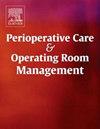A comparative study between the impact of ultrasound guided Pericapsular Nerve Group Block (PENG) versus Fascia Iliaca Compartment Block (FICB) on the quality of postoperative analgesia and ambulation in hip arthroplasty
IF 1
Q2 Nursing
Perioperative Care and Operating Room Management
Pub Date : 2025-01-18
DOI:10.1016/j.pcorm.2025.100469
引用次数: 0
Abstract
Background
Hip surgeries are one of the common orthopedic surgeries, especially in the geriatricnpopulation following trauma, postoperative pain control and early ambulation are the main concerns for decreasing hospital stay and postoperative complications. We aimed to analyze the ultrasound-guided pericapsular nerve group block (PENG) effect versus fascia iliaca compartment block (FICB) on the time needed for unaided mobilization and postoperative analgesics consumption in hip arthroplasty.
Methods
The study was a randomized, prospective, comparative study carried out at Ain Shams University Hospital where 44 patients subjected to hip arthroplasty were randomized into two equal groups; Group (F) in which patients received FICB under ultrasound guidance and Group (P) in which patients received PENG under ultrasound guidance. Both blocks were performed by injecting 20 mL of 0.25 % bupivacaine immediately after spinal anesthesia. The time needed for unaided mobilization was assessed by the time up and go test (TUG) and postoperative pain was assessed by visual analogue scale (VAS) in the first 24 h postoperatively.
Results
Regarding ambulation data over the first 24 h following surgery, the time needed for unaided mobilization was significantly shorter in the PENG group than FICB group. No statistically significant differences were determined between both groups as regards postoperative complications, total narcotic consumption, and VAS score. Conclusions: The Pericapsular nerve group (PENG) block demonstrated earlier unaided ambulation and delayed first rescue analgesia in hip arthroplasty compared to those who were administered Facia iliaca compartment blocks)FICB(in hip arthroplasty. Both blocks offered efficient postoperative pain control without difference in total opioid requirements.
超声引导下囊包膜神经群阻滞(PENG)与髂筋膜间室阻滞(FICB)对髋关节置换术后镇痛和活动质量的影响比较研究
髋关节手术是常见的骨科手术之一,特别是在老年外伤患者中,术后疼痛控制和早期下床是减少住院时间和术后并发症的主要关注点。我们的目的是分析超声引导下囊包膜神经群阻滞(PENG)与筋膜髂隔室阻滞(FICB)对髋关节置换术中独立活动所需时间和术后镇痛药物消耗的影响。方法:该研究是一项随机、前瞻性、比较研究,在艾因沙姆斯大学医院进行,44例接受髋关节置换术的患者随机分为两组;F组为超声引导下的FICB组,P组为超声引导下的PENG组。两种阻滞均在脊髓麻醉后立即注射20 mL 0.25%布比卡因。术后前24 h采用拔床时间(TUG)评估独立活动所需时间,采用视觉模拟评分(VAS)评估术后疼痛。结果关于术后24小时的活动数据,PENG组所需的独立活动时间明显短于FICB组。两组术后并发症、总麻醉用量、VAS评分均无统计学差异。结论:在髋关节置换术中,与髂筋膜隔室阻滞组(FICB)相比,囊包膜神经阻滞组(PENG)在髋关节置换术中表现出更早的独立活动和延迟的首次救援镇痛。两种阻滞均能有效控制术后疼痛,对阿片类药物的总需求量无差异。
本文章由计算机程序翻译,如有差异,请以英文原文为准。
求助全文
约1分钟内获得全文
求助全文
来源期刊

Perioperative Care and Operating Room Management
Nursing-Medical and Surgical Nursing
CiteScore
1.30
自引率
0.00%
发文量
52
审稿时长
56 days
期刊介绍:
The objective of this new online journal is to serve as a multidisciplinary, peer-reviewed source of information related to the administrative, economic, operational, safety, and quality aspects of the ambulatory and in-patient operating room and interventional procedural processes. The journal will provide high-quality information and research findings on operational and system-based approaches to ensure safe, coordinated, and high-value periprocedural care. With the current focus on value in health care it is essential that there is a venue for researchers to publish articles on quality improvement process initiatives, process flow modeling, information management, efficient design, cost improvement, use of novel technologies, and management.
 求助内容:
求助内容: 应助结果提醒方式:
应助结果提醒方式:


